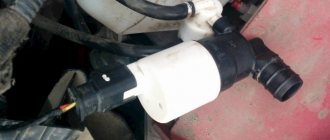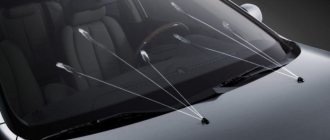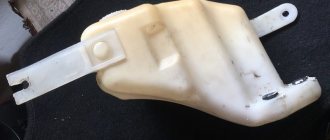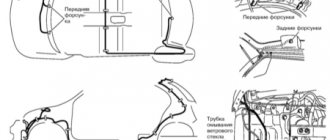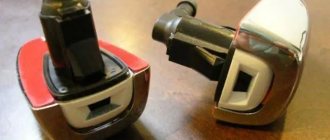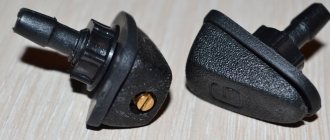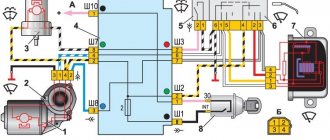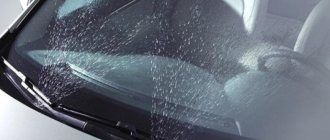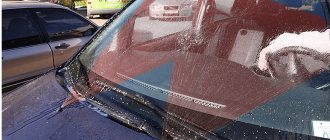Windshield washer - an invaluable thing. The benefits of this system are best demonstrated during slushy weather in late fall and early spring. However, even in the summer, life won’t seem like honey without a washer. Especially in cases where there is a need to travel a long distance, most of which will pass through rural areas.
Using washer fluid, insects that have broken against the windshield are removed. Usually, at the moment of a collision, they turn into wet colored spots, on which the driver’s gaze involuntarily focuses, distracting him from monitoring the road situation. Therefore, it is important to ensure that the windshield washer system is working properly.
The washer always works in conjunction with the wipers. If they are old and no longer fit tightly to the surface of the glass, the expected effect and high-quality cleaning will not work. Therefore, it is necessary to replace the cleaner brushes with new ones annually. Much depends on the quality of the liquid poured into the tank. Some are too watery and cannot handle dirt properly.
Some motorists consider it inappropriate to buy a washer, preferring to use ordinary water instead. However, due to the fact that “chemicals” were already splashing in the tank earlier, a reaction can occur as a result of which the filled water becomes rotten. In this case, the driver will experience discomfort, since when the windshield washer system is activated, he will inhale an unpleasant odor.
The operating principle of the system itself is based on the circulation of liquid through special tubes-hoses to the nozzles, through which it enters the windshield under pressure. Few people know that the jet can be adjusted manually , directing the flow of water lower or higher. This is done using a pin, which is inserted directly into the nozzle, after which the adjustment is made.
It happens that after activating the windshield washer system, no liquid is supplied to the glass . There may be several reasons for this. Most often, dirt has gotten into the nozzles, preventing water from coming out. You can clear the blockage using the same pin that is used to clean both nozzles. A guitar string can serve as a replacement for the pin, which can penetrate the system much deeper.
However, the reason for the lack of windshield washer fluid supply is not always a blockage. It is possible that there is a more serious problem. For example, the fuse responsible for the operation of the system may have blown, but in this case the wipers usually stop working. The problem is resolved by replacing the fuse.
In addition, a lack of fluid supply may be caused by a failure of the pump that ensures the system is operational. This is quite easy to understand. When the windshield washer is activated, you can hear a hum characteristic of the motor, vaguely reminiscent of the operation of a camera “zoom”. The absence of sound will be a clear indication of pump failure. However, it breaks down gradually: at first the stream becomes noticeably weaker, after which it dries up completely.
The windshield washer pump is usually located at the bottom of the system fluid reservoir. You can get to it by lifting the car on a jack, but it is much more convenient to do this in a pit. Removing the pump is simple: first disconnect the wires connected to it, after which the device itself is removed. Everything comes back in reverse order.
Do not forget about the need to use seasonally appropriate liquid in the windshield washer system. Before the onset of cold weather, take the trouble to get rid of the remnants of summer water. Otherwise, it will inevitably freeze, causing the system to fail for a long time. If the liquid is completely filled at the moment of a sharp drop in temperature, the tank itself may crack, replacing which costs a lot of money.
A windshield washer is an important component of any modern car. It is designed to spray glass with cleaning liquid, which not only helps clean them of dirt, but also prolongs the life of the wipers. The windshield washer mechanism is simple and compact. Its components include:
• washer pump;
• liquid tank;
• nozzles (jet);
• auxiliary parts (wiring, tubes, valves).
- How the windshield washer works: Reservoir
- Pump
- Injectors
- Heating the washer fluid
Did you know? Some cars also supply water to the rear window, headlights, and even mirrors. In this case, the package will include a washer fluid level sensor.
How the windshield washer works
The operating algorithm of the windshield washer is simple. The pump creates pressure, thanks to which liquid from the tank flows through the nozzles onto the glass.
Tank
The windshield washer reservoir is located under the hood of the car; it is installed as far as possible from the engine to avoid heating, deformation or melting. Functions as a water storage. In most cases, for convenience, its lid is marked yellow and made oval. The tank volume ranges from 2.5 to 5 liters (depending on the model). It has a filler neck and often a protrusion for installing a washer pump (for example, VAZ tanks have one).
Pump
It is firmly attached to the tank using an O-ring. This is the only moving part. Different models may vary in design complexity, but will consist of an oil seal, impeller and brushes. Often the car is equipped with a deep cleaning filter in front of the pump. It is actually a small motor powered by direct current.
A sure sign of engine failure is a stop in the flow of windshield washer fluid.
Injectors
Simply put, these are holes through which liquid gets onto the windshield. They are located on the hood or “jabot”. They are usually mounted in pairs so that the windshield washer fluid hits the center of the glass. Jets are divided into two types: fan and jet. The former are considered more efficient due to stronger pressure and more nozzles.
Did you know? In order to calibrate the direction of operation of the jet nozzle, it is enough to turn the nozzle in the desired direction using a needle.
We recommend: Fan windshield washer nozzles: how they work
Using windshield washer in winter
If you do not want to ruin the entire windshield washer mechanism, then you should take into account the temperature conditions of our winter and take care in advance to ensure that the liquid in your washer does not freeze.
Heating the washer fluid
One of the means that supports the proper operation of the windshield washer in winter is a variety of washer fluid heating systems. They can be used either separately or in combination. These include: heating the tank using coolant or a heater in the tank itself; insulation of tubes and their electric heating, as well as electric heating of jets.
Important! Experts do not recommend using heated liquid in severe frosts and an unheated interior.
How to prepare “non-freeze”
Now let's turn our attention to the washer fluid itself. In winter, it is not advisable to use just water. To perform its functions, all kinds of “anti-freeze” agents are used. When making such a solution at home, alcohol (methyl, ethyl, isopropyl), detergents, water, fragrances, dyes, etc. are often used.
Important! Since 2007, legislation has prohibited the use of methanol in windshield washer fluid due to its toxicity.
Water should be distilled or pre-filtered. Be sure to check the finished “anti-freeze” product. To do this, pour a little of the finished product and leave it in the cold for several hours. Suitable windshield washer fluid will not thicken or freeze even in the winter cold.
The Internet is replete with all sorts of recipes for homemade “anti-freeze”. We give an example of one of them, suitable even at -20°C.
Take:
• 3 liters and another half glass of water;
• 250 g of medical alcohol (96%!);
• 1 tbsp. l. washing powder.
Stir the powder in half a glass of water, filter, add to the mixture of alcohol and water. Done. We hope that the information about the windshield washer, its components (reservoir, pump, windshield washer nozzles) and the features of its operation in winter was useful to you. Have a comfortable ride at any time of the year!
Subscribe to our feeds on social networks such as Facebook, Vkontakte, Instagram, Pinterest, Yandex Zen, Twitter and Telegram: all the most interesting automotive events collected in one place.
Device Features
There are new and old motors. The latter can be found on Soviet cars, or on VAZ 2107, 2108, for example.
Most cars, including the VAZ 2109, 2110, 2114, as well as foreign cars Mitsubishi Lancer, Pajero Sport or Ford Focus, already use new types of washer motors (pumps).
The main components of the washer are:
- nozzles;
- pump (motor);
- reservoir with washer fluid.
Nozzles are used to supply water to the windshield of a car. Therefore, they should be positioned so that the outgoing stream of liquid hits the center of the headplate as much as possible. The pump supplies water to the tank. By the way, on some cars, wash water is supplied not only to the windshield, but also to the main headlights in front and behind.
It doesn't matter what kind of car you have. It could be a Priora, a Hyundai Accent, some Mazda or Toyota. All the washer motors work on the same principle. Although the device, characteristics and appearance may vary.
Pumps supply water or washer fluid. If the windshield washer does not work, most likely the reservoir or the nozzles themselves are broken. They can be replaced or repaired yourself.
If the pump breaks, the task is a little more difficult. It is important to immediately identify the problem and fix the breakdown. Driving a car, especially in bad weather, when the windshield wiper does not work, is dangerous.
Causes of malfunctions
Don't rush to blame the engine for everything. It may work, but the windshield wiper does not function for other reasons.
Let's look at the key reasons why our wipers stop doing their job.
- Clogged filter or nozzle. Frequent breakdown. Especially for those who use tap water instead of special washer fluid. To solve the problem, you need to dismantle the devices and flush the system. The work is not difficult, but delicate;
- Supply hoses. They wear out over time, lose their tightness, and burst. Everything is simple here. Remove the old hoses and install new ones. Their price is cheap even on foreign cars;
- Incorrect connection. While carrying out some repair work on the wipers themselves or nearby components, you could disassemble the washer system and reassemble it incorrectly. Check connections and correct errors made during assembly;
- Electric motor and pump shaft. It happens that the connection between them is weak or completely broken. What to do? Right. The element needs to be better secured;
- Motor failure. It doesn’t happen that often, but you shouldn’t rule out this option. Before changing a part, try to clean the motor and its brushes, and get rid of all traces of corrosion. Sometimes it helps. If the repair does not produce results, replacement will help.
Here are the main causes of windshield wiper failure. It is not the most complex mechanism in a car, so you can repair it yourself.
Ways to solve problems with washer fluid freezing
Drivers regularly face the problem of liquid freezing during the winter season. Even the most resistant substances may not retain their properties in severe frosts. As a result, some drivers turn off the system until the weather warms up, while others use alternative solutions to the problem. What to do if the windshield washer freezes:
- Move the car to a warm, heated garage or parking lot until the fluid restores its previous properties. This option is suitable only for those who have free time and access to insulated premises.
- Temporarily remove the water tank, if possible, and warm it indoors. After defrosting, the tank must be installed back.
- Fill the reservoir with anti-icing washer fluid, which is designed to work in extreme conditions, including the range from -70 to -50 degrees.
In winter, it is not recommended to completely fill the washer reservoir. Due to the expansion of frozen liquid, the reservoir may crack or burst.
Causes of washer malfunction
If the windshield washer does not work, it will not be difficult for an experienced driver to identify the cause of such a malfunction, and even a beginner, after familiarizing himself with the main failures in the cleaning system, will be able to eliminate them on his own.
Mechanical problems
The most important reason, as mentioned above, may be the lack of washer fluid; in this case, you just need to top it up. If it is present, but does not splash in the winter, then perhaps it is simply frozen. In this case, the problem can be solved in one of two ways:
- warming up the engine;
- bringing the car into a warm garage.
We recommend: Signs of car tire wear
After the liquid has thawed, the system will begin to operate as usual, but it is better to drain the water from the tank after this and replace it with an “anti-freeze” one.
If you are interested in information about how to make an antifreeze with your own hands, read the material from our specialist.
Other significant mechanical reasons why the windshield washer does not spray include the following factors.
- Clogged injectors . Their exit can be blocked by various debris: rust, dirt or small particles. To check the correctness of the guess, you need to stop the supply of working fluid to the nozzles; if this is the case, then the supply of “anti-freeze” will be normal. The solution to this problem lies in replacing the nozzles.
- Disconnecting the hose . It may simply fly off while driving on bumpy roads, and then the fluid supply will continue, but the headlight and windshield washer nozzle will remain dry. Sometimes this happens in cars in which the connecting fittings are located on the hood, then when it is closed, the hoses are squeezed. In any case, the deformed or torn tube must be replaced and returned to its place.
Electrical faults
After checking the fluid level, the cleanliness of the injectors and the hose leading to them, it may turn out that all this has nothing to do with it, then the issue is for the following reasons:
- Fuse blown . You will need to find the safety block and check the insert; it can be found using the attached diagram, which is usually printed on the cover or in the car’s operating instructions. After checking, if this is indeed the reason, then you need to replace the damaged part
- Motor failure . To establish the accuracy of your guess, you should connect a multimeter to the motor terminals and check the voltage when you turn on the washer. If the voltage indicator is normal, but the motor remains inoperative, then the problem lies with it. You can determine which motor has failed by elimination, by moving the pump terminals from the windshield to its rear counterpart.
- Washer switch malfunction . It is usually located on the steering wheel. If, after checking the voltage, it is missing, and replacing the motor with a new unit did not help, then it turns out that the windshield washer switch or relay is not working. Only an experienced auto electrician can accurately diagnose a breakdown.
- Oxidation of pump terminals . During operation, they can not only oxidize, but also completely fall off, which is why the motor stops pumping liquid. To return everything to working condition, you need to clean the oxidized terminals or replace them with new ones.
In a workshop
- Adjust and clean the washer nozzles
- Removing the pump and cleaning it may restore full functionality of the system.
- Check to see if the engine is in good condition or needs to be replaced.
- Check the condition of the power cord and connector supplying power to the motor.
- Seal connections between the pump and lines that may be a source of leakage.
- Replace the damaged combination switch under the steering wheel if it is responsible for the inability to start the washer system,
- In case of other malfunctions, the parts are replaced with new ones.
Access to the system is easy in most cases. The wheel and wheel arch must be removed. Then unscrew the liquid container. In its lower part there is a pump with a motor, from which lines leading to the nozzle are drawn.
Replacing the tailgate injector power cable requires disassembling a few items, but it certainly doesn't have to be a complicated operation.
Nozzle selection
Today, most car owners use fan washer nozzles. Their advantage is that water does not fall onto the windshield in drops or in a couple of jets of liquid, but at once in a large number of small drops, thanks to which most of the glass is immediately covered. This is the main advantage of fan-type wipers, thanks to which the wipers begin to work on wet glass, carefully removing sediment or dirt.
Of course, this ensures the least risk of the wipers leaving scratches on the surface of the glass, since the sweeps will no longer occur on a dry surface. Many car owners also claim that using this type of nozzle reduces windshield washer fluid consumption. The only drawback is their unusual design, which is why they quickly freeze in the cold season, but in this case it is recommended to immediately select and install elements with a heating function.
There are recommendations that you need to choose original injectors, according to the make of your car. But these can be expensive and, in this case, you can choose non-original ones. The alternative will cost less, but some improvements are possible. The most common injectors, which are suitable for installation on many brands of cars, are from Volvo S80, and an even cheaper option is from SsangYong. Skoda fits perfectly on Daewoo Lanos and Chevrolet Aveo cars. Also, for example, elements from the Mitsubishi Galanta produced in 2008 are suitable for many car models.
Their standard configuration may not include a check valve. Thanks to it, liquid is prevented from flowing back into the washer reservoir if the suction pump does not work.
It is this valve that ensures a continuous supply of fluid. It has the shape of a spring-loaded ball and closes the hole in the nozzle if liquid is not supplied to the glass by the washer.
In general, you can do without this valve, but then you will need to think of another way so that the wipers do not work before the water is supplied to the glass. Such a valve can also be selected from different cars, for example from VAZ 08 or 09, Toyota or Volvo.
Additional heating system
One of the current options for winter is the installation of an additional heating system for the windshield washer reservoir and nozzles. The car owner can forget about problems with liquid freezing or icing of pipes.
Equipment manufacturers produce standard-shaped injectors with built-in heating. Resistors are used to maintain temperature and prevent icing. The power supply passes through the resistance, as a result of which heat is generated, which prevents the element from freezing. The liquid supply tubes are specially insulated, and electric heaters can be used to heat the tank.
A windshield washer is a must-have device, without which it is difficult to imagine a car. It allows you to increase the safety and comfort of driving a vehicle.
Washer fuse location
In different cars, the fuse blocks and the fuses themselves are located in different orders; there is no single standard so that the block is, for example, on the right and there is a certain order of which fuse is responsible for what. Find out the location of the block and a specific fuse, for example, when replacing the cigarette lighter fuse. Therefore, we will consider for specific brands and models of cars in the photo.
On a VW Jetta 6 (Volkswagen Jetta 6), the washer fuse is located in the engine compartment, to the right of the engine.
Location of the washer fuse in the block of the VAZ 2110. The block itself is located in the passenger compartment on the driver's side. The fuse responsible for the operation of the washer is number 9 (second from the right from the top).
Location of washer fuse Wolksvagen Passat B7
We recommend: Car wheels and tires. Their structure and markings
How to replace washer nozzles
The process of replacing injectors is the same for all cars. Before starting work, it is necessary to prepare new hoses through which the “wash” will pass. A tube that is used for aquariums is well suited for these purposes.
After this, you need to complete the following steps:
- Remove the upholstery and carefully pull out the plastic clips.
- Remove the buffer foam pads. They are usually held in place by tape, so to reinstall them you will need to prepare some fresh duct tape.
- Detach the covers on the plastic parts.
- Remove the hoses through which the fluid is supplied.
- Remove the old injectors.
- Connect the pipe to the new jets.
- Connect the check valve to the jet connections and pipes.
- Check the system operation.
When replacing standard nozzles, it is also necessary to purchase a check valve, which will not allow the fluid to “roll back”, due to which the wipers often start working long before the cleaning composition appears on the glass.
Sometimes new washer nozzles do not work as expected (the fluid flows too high or low, offset to the side, etc.) and in this case additional adjustment of parts may be required.
Improvement for windshield cleaning
Refinement and improvement of the windshield, windshield and rear window washers significantly improve operation.
Improving the washer's performance is as follows: you need to buy a new reservoir with the ability to install one or more motors. There are tanks with recesses for two motors. Also, according to the material, there are soft and hard plastics, hard ones last longer and withstand ice (if the water or anti-freeze is frozen). Some people connect one motor to one injector. At the same time, the flow rate increases, but the pressure increases. In general, watch the video on modifying the washer.
Replacement
If the old motor has failed, there is no point in trying to repair it somehow. To buy a new part, you will have to spend very little money. And the replacement procedure on most cars is extremely simple.
I will describe the main stages of work associated with replacing this element of the windshield cleaning system of any car.
- Turning off the vehicle's power. A safety measure without which further work makes no sense. Be sure to remove the negative terminal from the car. It's simple but important. Otherwise, you not only risk burning the wiring, but also getting an unpleasant electric shock yourself.
- Search for a motor. It all starts with identifying where your windshield wiper motor is located. It depends on your car. On some cars, just lift the hood and you will immediately see the washer reservoir. The motor itself is located on the reservoir (partially inside) of the windshield wiper, into which the liquid is poured. Do you see the tank? If yes, then you are in luck. If not, then you will have to look for it by removing elements of the engine compartment. On some car models, the tank is hidden so that the fender protection has to be removed.
- Disconnect the connectors with wires from the motor. Then remove the tank itself.
- The hose and fitting are separated from each other. Don't forget to drain the liquid. Filling a new one will not be difficult. Yes, and for prevention it won’t hurt to do it.
- Using a screwdriver, push the intake seal out of the bushing. This will allow you to completely remove the windshield washer motor.
- Don't forget to install a new bushing when reassembling. This often leads to the washer pump itself breaking down. So the old bushing goes to the landfill.
- Reassemble the assembly in reverse order. Here many craftsmen relax, because they consider the work done. In fact, reassembly causes more problems than disassembly. Advice from someone who made similar mistakes. That is, from me. Do not try to remember the location of parts unless you are confident in your memory capabilities. We got distracted by something, forgot, got confused. This happens to everyone, and there is nothing wrong with it. To ensure proper reassembly sequence, you can record, mark, or label the parts in the order in which they are removed. This will make it easier to put everything back together the way it was before.
The instructions are for informational purposes only, as the procedure may differ depending on the car model. Consult your machine's owner's manual for assistance. This is the best visual aid for self-repair.
There is nothing complicated in this work. Even the car owner who prefers to solve most problems with the help of a car service can easily cope with it. Repairs cost several hundred rubles and take a maximum of a few hours.
Cleaning injectors
If you notice that the stream of fluid has become weak, it means that the washer nozzles are most likely clogged and it’s time for you to clean them. You can do this yourself; for cleaning you will need: something thin (string, wire, needle or pin), a twenty-cc large syringe, water, soap and a compressor.
You definitely need to check if they are really the problem. To do this, you need to check that there is water in the washer reservoir, then you need to disconnect the hoses that supply fluid and turn on the suction. If there is a good stream from the tubes, this means that you really need to clean them.
- After disconnecting the water supply hoses, rinse the nozzle thoroughly with soapy water, and then attach the hose from the compressor back and blow it out.
- Fill the syringe with water and thoroughly, in the opposite direction, rinse the nozzle. Carefully clean the nozzle hole with a thin object (for example, a needle, etc.), and then rinse it with water using a syringe.
- If your car has a dismountable one, you disassemble it, clean it, and then put it back together and install it.
- After installing it back on the car, it is worth flushing the entire system.
If clogging of the elements begins to occur frequently, then the washer barrel itself may be clogged, so check it for debris.
When installing universal headlight washer nozzles or windshield jets, try to adjust them so that they spray liquid onto the surface of the glass without going beyond it. When choosing fan jets, try to give preference to those models that were designed specifically for your car, this will save you time on installing the elements.
Prevention measures
In order to avoid sudden problems with the operation of the windshield washer system, you must:
- promptly refill the washer reservoir with antifreeze liquid and remove water from the system;
- check the quality of the antifreeze in the freezer; it is better to buy liquid at a gas station;
- remove the chip from the pump and inject silicone grease into the contact area, it pushes water out of the contact area, preventing corrosion;
- if the tubes crack, replace them with serviceable ones, you can take silicone tubes from an IV (sold at any pharmacy);
- When operating a vehicle at temperatures below minus 25 degrees Celsius, it is recommended to install heated injectors.
This is interesting: Oil scraper rings and caps - replacement if stuck, decarbonization
